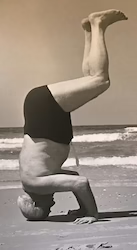
Feeling stiff? Here’s something you can explore while sitting at your computer.
….. We tend to make our movements fast and jerky, which actually increases our stress. Thus the first step is to interrupt this habit.
The Shoulder Clock Lesson
Text of the lesson: For this lesson, sit comfortably at the front of the chair, with your feet on the ground.
- Breathe in and out. As you breathe in, count ,”1… 2… 3… 4……” (as far as is comfortable)
and as you breathe out, also count, “1… 2… 3… 4……”.
Repeat five times.- As you breathe, observe where your left shoulder is and feel how it responds to your breath. Does it move with your breath? … how does it move?
- As you breathe, observe where your left shoulder is and feel how it responds to your breath. Does it move with your breath? … how does it move?
- Stop that and imagine a clock on the wall to your left. You will notice that 12:00 is in the direction of your head and 6:00 in the direction of your feet.
Gently slide your shoulder in the direction of 12:00, and back to where you started.
Repeat five times.- How easily does it move? Does it move in a straight line or does it meander around?
… How smooth is the movement? …
Don’t try to over-do and instead do the movement gently to observe the quality of your motion.
- How easily does it move? Does it move in a straight line or does it meander around?
- Move the shoulder in the opposite direction, to 6:00. Repeat five times.
How does this compare? How does your breath move, and how does it relate to the movement of your shoulder blade? - Slide your shoulder in the forward direction, toward 3:00 on your imaginary clock. Again, repeat five times.
Does your body turn forward or back with this movement? - Slide the shoulder in the opposite direction, toward 9:00. Repeat five times.
Which is the easier direction, 3:00 or 9:00? - Gently move your shoulder in a circle clockwise, traveling from 12:00 to 3:00 to 6:00 to 9:00 and back up to 12:00. Repeat five times.
Reverse the direction. Again, repeat five times. - As your shoulder circles, observe how you are breathing, the ease of your shoulder movement and whether the rest of you participates, even a little bit.
- Rest, maybe at the back of the chair.
Compare the two sides of your body. What differences do you notice between the two sides? - Now sit forward and repeat the directions with the RIGHT side, but this time just do the movements in your imagination.
Are you able to do the movements gently and without holding your breath? - Sit back again and compare the two sides of your body. What differences do you feel now?
Stand up and walk around and feel how your arms move as you walk. Do you feel your arms swing with a new sense of ease as you walk?






